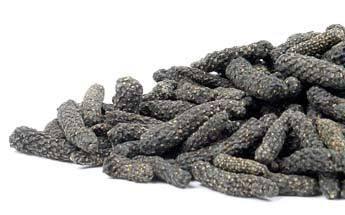Peppercorns, Long - PIPER LONGUM
(Whole) (Organically Grown) Available in 1 OZ
COMMON NAME
Standardized: long pepper
Other: jaborandi pepper
BOTANICAL NAME
Piper longum L.
Plant Family: Piperaceae
INTRODUCTION
The long pepper has been used for centuries in Mediterranean, African, Indian, and Indonesian cooking, although it has almost fallen into obscurity in the past few hundred years. The long pepper comes from a flowering vine with large catkin flowers. Within each flower are small black spikes that are the actual pepper. The taste is very similar to regular black pepper, and it is a relative of the species piper nigrum, but with a much hotter taste and an almost earthy, sweet overtone. It has been reported that Attila the Hun demanded part of the ransom for his sacking of Rome to be paid in long peppers. One of the most notable uses is as an ingredient in herbal medicine includes adding long pepper with ginger and black pepper in a popular base ingredient in Ayurvedic medicine called Trikatu.
PARTS USED
The entire catkin or spike. When broken or ground up it imparts an even greater pungency to food.
TYPICAL PREPARATIONS
Used as a spice for a variety of dishes, or as a substitute for regular black pepper. On a global scale, it has been used in pickles, preserves, curries, soups, sauces, or ground up and tossed with fresh fruit.
SUMMARY
The word pepper comes from the Sanskrit word pippali, which is Sanskrit for long pepper. On a more macabre note, practitioners of western occult arts have used the long pepper in a formula to help create the fabled "Dead Man's Hand", a grisly talisman that is said to impart invisibility and protection to its owner.
PRECAUTIONS
Specific: Not for use in pregnancy except under the supervision of a qualified healthcare practitioner.
General: We recommend that you consult with a qualified healthcare practitioner before using herbal products, particularly if you are pregnant, nursing, or on any medications.
*These statements have not been evaluated by the Food and Drug Administration. These products are not intended to diagnose, treat, cure or prevent any disease.*
